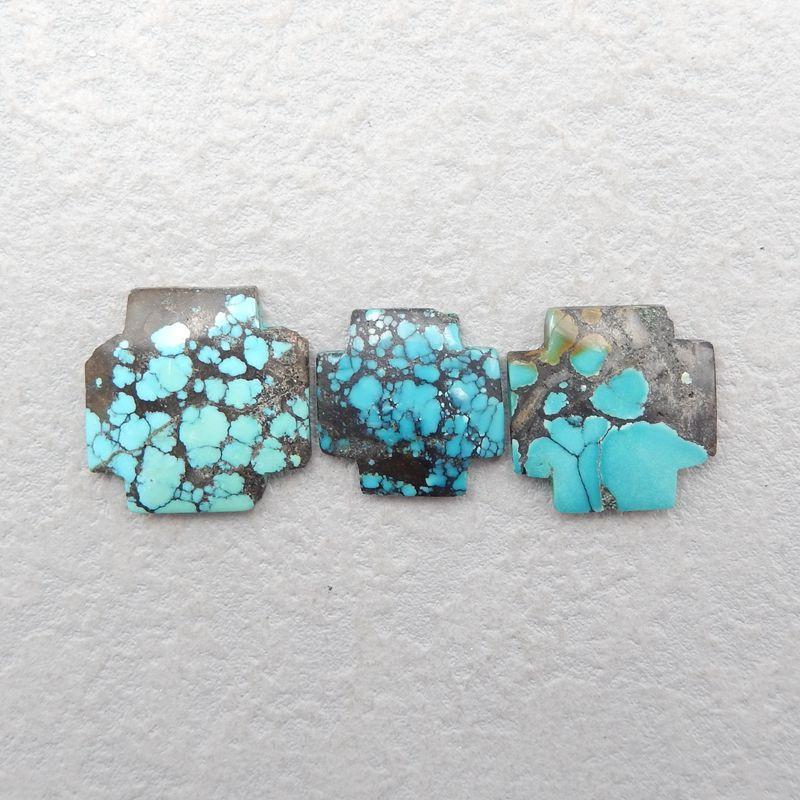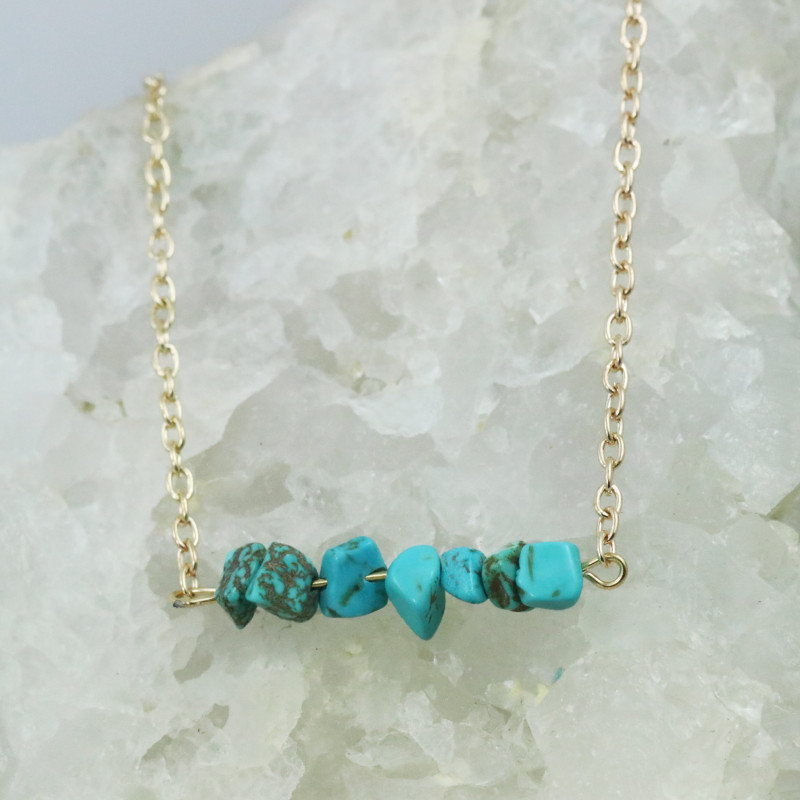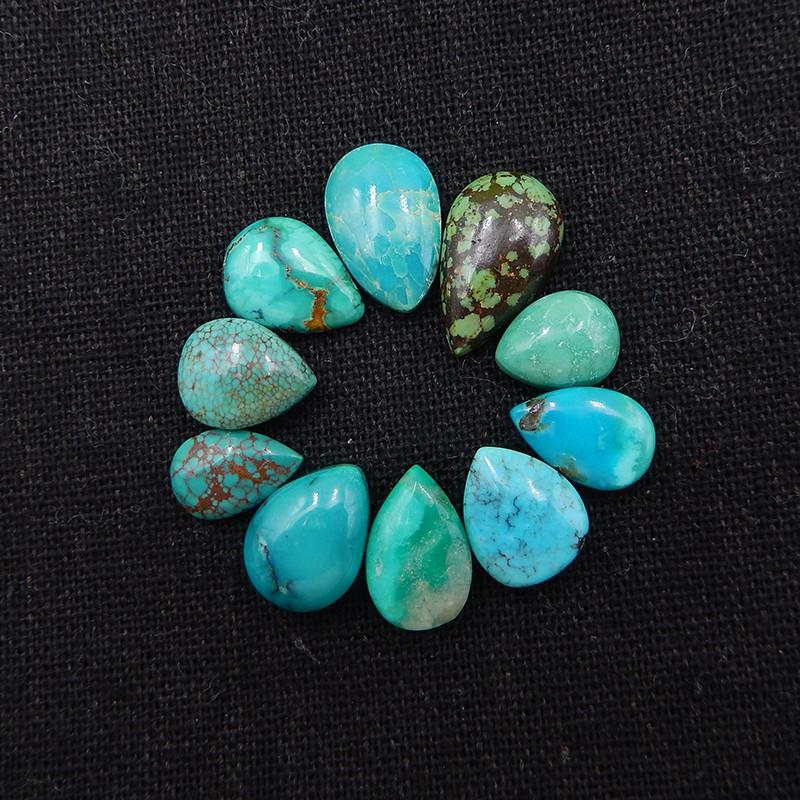
绿松石:益处、意义、特性和用途
 说到令人叹为观止的大海和天空之美,绿松石绝对是您的最佳伴侣!绿松石是一种富含铜和铝的磷酸盐矿物,因其多种特性和用途而备受青睐。无论您寻求的是疗愈、庇护还是美丽,绿松石都能满足您的需求!
说到令人叹为观止的大海和天空之美,绿松石绝对是您的最佳伴侣!绿松石是一种富含铜和铝的磷酸盐矿物,因其多种特性和用途而备受青睐。无论您寻求的是疗愈、庇护还是美丽,绿松石都能满足您的需求!
在本指南中,我们将深入探讨绿松石的丰富规格、含义、疗愈功效等等。让我们开始吧!
关于绿松石
绿松石是蓝绿色的磷酸盐矿物,以其舒缓的能量和海洋般的美丽而闻名。几千年来,人们一直对绿松石首饰趋之若鹜。无论您是戒指、吊坠、珠子还是项链的爱好者,绿松石都绝对是您的惊艳之选!
如果您或您所爱的人的生日在十二月,您可以欣然接受 绿松石作为您的诞生石!绿松石清凉的蓝色调与冬季出生的宝宝完美搭配。
同样,如果你的星座是射手座或摩羯座,绿松石也是你的完美之选。对于雄心勃勃、热情洋溢的射手座来说,绿松石可以帮助你获得成功。对于坚强但往往固执的摩羯座来说,绿松石可以帮助你促进更开放的沟通。
让我们来点科学的!绿松石是一种富含铜和铝的水合磷酸盐。这意味着如果你把绿松石浸入水中,它会吸收液体。
绿松石是一种多孔矿物, 莫氏硬度介于5-6之间,略低于石英。与日常物品相比,绿松石比钢钉还要软!
让我们更深入地了解绿松石宝石的成分。

绿松石的规格和特征
颜色:绿松石色、浅蓝色至深蓝色、蓝绿色、黄色
晶体结构:三斜晶系
光泽:玻璃光泽(晶体)、蜡状光泽或暗淡光泽(块状)
透明度:透明至半透明(罕见)、不透明
折射率: 1.590-1.650
比重: 2.40-2.90
解理:无(大量)
现在我们已经了解了绿松石的化学特性,那么绿松石象征着什么呢?

绿松石的含义
绿松石这个名字源于17世纪的法语单词turquois,意为“土耳其”。毕竟,土耳其旅行者首先将产自波斯矿场的绿松石介绍给了中世纪的欧洲。
绿松石是幸运石吗?没错!绿松石是人们喜爱的幸运象征,能为您带来成功和财富。下次您追求职场晋升时,不妨带上一些绿松石,增添好运。
除了好运,绿松石还象征着希望和宁静。不妨用这颗天蓝色的宝石装饰您的家或办公室,收获应得的宁静与幸福。您甚至可以用绿松石进行冥想,无论是单独摆放还是放在水晶格中。
最后,绿松石的象征意义在于抵御危险,尤其是个人健康。根据民间传说,如果你的绿松石碎裂,就应该将其视为危险的警告!如果你的绿松石颜色变浅,你可能很快就会生病。同时,完全褪色可能预示着主人的死亡——当然,这也是绿松石的传说和传奇的一部分。
说到您的健康,绿松石的治疗功效是什么?

绿松石的治疗功效
像大多数宝石一样,绿松石也是一种具有强大治疗功效的宝石。那么,绿松石到底有什么好处呢?
绿松石物理治疗
增强免疫系统
吸收营养
再生受损组织
治愈眼睛和喉咙痛
缓解身体疼痛
绿松石情绪疗愈
对抗抑郁和疲劳
预防恐慌症
促进内心和谐
绿松石精神疗愈
提高自我实现
激活心脏、喉咙和第三眼脉轮
稳定下部脉轮
那么,脉轮到底是什么呢?脉轮是神圣的能量中心,从头顶流向脊柱底部。
心轮是你爱、慈悲和同理心的中心。喉轮掌控着你沟通和表达的能力。最后,第三眼轮开启了你的直觉和远见。
当你的脉轮被阻塞时,你可能会遭受身体和精神上的痛苦。幸运的是,绿松石可以打开这些脉轮,从内而外地治愈你。
纵观历史,人们还如何推崇绿松石的独特属性?

绿松石的历史
数千年来,世界各地的社会都珍视绿松石。大约从公元前3000年开始,古埃及人就开始开采绿松石用于珠宝和礼仪用途。古代中国和美洲文明后来也采取了同样的做法。
还记得绿松石能带来好运吗?这种信仰跨越了几个世纪,存在于不同的文化中。
例如,阿兹特克人崇敬绿松石,就像其他社会崇敬黄金和祖母绿一样。阿兹特克人用绿松石作为祭品来祭祀他们的神灵。根据阿兹特克神话,羽蛇神(Quetzalcoatl)传承了切割和抛光绿松石的技艺。
由于绿松石的特殊地位,阿兹特克统治者佩戴绿松石串珠手链作为护身符。受人尊敬的酋长去世后,下葬时嘴里还会含着绿松石碎片。
在北美洲,阿帕奇部落相信绿松石拥有许多神秘的力量。因此,阿帕奇人会佩戴绿松石护身符、珠子和吊坠来装饰自己。如果没有绿松石,阿帕奇萨满就会被视为非法。
正如我们之前提到的,古波斯(今伊朗)通过土耳其旅行者将绿松石引入中世纪的欧洲。在维多利亚时代,绿松石的受欢迎程度激增。珠宝商喜欢将绿松石镶嵌在黄金中,现代珠宝商也倾向于效仿这种做法。

绿松石的起源
大部分绿松石存在于结核矿床和围岩中,以脉状或浅层壳状形式存在。当你观察绿松石时,你会发现其表面布满了色彩斑斓的脉状纹路。
这些脉状或斑块被称为“母岩”,是绿松石形成母岩的残留物。一些常见的母岩包括玉髓、蛋白石和白色高岭石。母岩会影响宝石的颜色和坚固性。
绿松石是一种次生矿物。与结晶过程中形成的原生矿物不同,次生矿物是在后期风化过程中形成的。
其他常与绿松石一起生长的矿物是孔雀石和硅孔雀石。与绿松石一样,这两种宝石都带有蓝绿色调,并含有大量的铜。
我们在世界哪里可以找到绿松石?
绿松石产地
美国和中国是全球最大的绿松石供应国。在中国,湖北省和陕西省拥有绿松石矿。中国绿松石颜色从淡蓝色到浅绿色不等,通常比美国绿松石更软。
在美国,内华达州、亚利桑那州、科罗拉多州和新墨西哥州都出产优质绿松石。内华达州开采的绿松石宝石比其他所有州的总和还要多!
然而,美国最著名的绿松石矿藏位于弗吉尼亚州林奇站。在这里,您会发现世界上唯一的透明和半透明绿松石晶体产地。如果您能从这里开采出绿松石,那么您手中就拥有了一颗极其稀有珍贵的宝石!
在世界各地,伊朗矿山历来都供应一种备受推崇的绿松石,被称为“波斯级”。波斯级绿松石呈天蓝色,没有可见的基质。
如今,一些伊朗矿场仍在出产波斯级别的宝石。亚利桑那州的睡美人矿场也出产类似的宝石。
全球其他绿松石矿包括:
澳大利亚
智利
巴西
印度
墨西哥
一旦原始绿松石宝石准备好上市,就该去购买珠宝了!

绿松石宝石属性
当您购买优质绿松石首饰时,您需要评估以下宝石特性:
颜色。绿松石的颜色范围从青绿色到蓝色,有时甚至会变成黄色。绿松石的蓝色来自铜,绿色来自铬和钒,黄色来自铁。如果您喜欢矩阵图案,可以考虑购买一块带有蕾丝图案黑色矩阵的蜘蛛网状绿松石!
克拉重量。绿松石宝石的市售重量通常在4-8克拉左右。较大的宝石非常适合用作装饰品。
净度。大多数绿松石是不透明的——它们呈现出哑光效果,并含有色彩斑斓的蜘蛛网状内含物,称为基质。绿松石基质的图案美得令人窒息,颜色从黑色到金色不等。
切工。宝石级绿松石通常被雕刻成凸圆形宝石、镶嵌或雕刻品。低等级的绿松石则被打造成珠子,无论是抛光的还是“块状”的。
最后,您可能需要考虑合成的或经过处理的绿松石宝石。

处理和合成材料
大多数绿松石宝石在上市前都会经过某种形式的处理。宝石处理是完全安全且标准的程序,可以提升宝石的颜色和净度。对于某些绿松石宝石来说,这意味着将其浅色加深为深色且浓郁的色调。
合成绿松石确实存在,无论是否带有母岩图案。常见的合成材料包括玻璃、塑料和陶瓷。一些天然宝石,例如磷铝石,通常与绿松石外观相似,可以作为替代品。
皮埃尔·吉尔森公司于1972年创造了最著名的合成绿松石。与许多其他合成绿松石不同,这些人造绿松石宝石几乎与天然绿松石难以区分。然而,如果在显微镜下比较这两种绿松石,你会发现天然绿松石表面光滑,而皮埃尔·吉尔森绿松石则具有燕麦般的纹理。
货比三家时,请记住,很多绿松石宝石可能根本就不是绿松石!它们可能是其他矿物,或者仅仅是绿松石色的物体。
例如,白纹石和菱镁矿经常被染成蓝色,以模仿绿松石——一定要留意这些!务必与卖家确认,并仔细阅读产品说明。
说到小心,让我们来探讨一下如何最好地保养我们的绿松石首饰。

绿松石的保养和维护
作为一种相当精致的宝石,您需要对绿松石投入额外的爱护和呵护!
话虽如此,一定要妥善保管你的绿松石首饰,以备不时之需。如果你打算购买绿松石戒指,别忘了选择保护性镶嵌,以保护你的珠宝。将绿松石存放在衬有织物的容器中,远离其他宝石,以免刮伤。
另一个需要考虑的重要事实是,绿松石吸收液体和气体的速度非常快。因此,您应该将珠宝远离高温和化学物质。这样可以避免造成不可逆转的损害!
清洁绿松石时,避免使用肥皂、清洁剂和机械清洁剂。绿松石孔隙率高,容易吸收这些有害化学物质。
相反,用湿布擦拭宝石,然后小心地擦干。每次佩戴珠宝时,都要这样做,以保持其清新洁净。
我们已经介绍了购买哪种绿松石首饰以及如何保养。那么,绿松石到底值多少钱呢?

绿松石的价格和价值
绿松石作为一种广受欢迎且珍贵的宝石,价格昂贵也就不足为奇了。顶级绿松石每克拉的价格高达500美元!
然而,绿松石的价格种类繁多,价格灵活——对于预算有限的人来说,这绝对是个好消息!事实上,绿松石首饰的价格低至每克拉5美分。如果您正在寻找中档价格,可以找到每克拉30-40美元的优质绿松石。
是什么造成了如此不同的价格范围?颜色均匀度和饱和度在绿松石估价中起着重要作用。
一般来说,颜色越深的宝石价值越高。绿色或蓝绿色的绿松石宝石价值较低,因此价格也较低。(当然,如果你喜欢绿色,那就尽情选择吧!)
哪种绿松石最值钱?很多人认为我们之前提到的波斯绿松石是最值钱的绿松石品种。波斯绿松石色泽深邃浓郁,且几乎没有内含物,绝对是难得的珍品!
最终,无论您的风格或预算如何,都能轻松找到适合您的绿松石首饰。绿松石的用途真是多变!

今天就珍惜绿松石!
我们分享了关于绿松石的所有知识——从古埃及人到阿兹特克人,再到现代社会,历史见证了绿松石的强大与魅力。你准备好在线购买绿松石了吗?
这颗宁静的蓝色宝石蕴藏着丰富的磁性和用途。无论您需要的是护身符、疗愈水晶、美丽的诞生石,还是华丽的珠宝,绿松石都是您的理想之选。只需一小块绿松石,就能点亮您的每一天!
想买绿松石吗?快来 Gem Rock Auctions 选购绿松石吧!
搜索Gemstone Encyclopedia
最新的文章
棕榈象牙雕刻,又称植物象牙,是象牙的天然替代品,取自南美洲棕榈树(Phytelephas palm)的果实,并以符合伦理的方式采集。本指南将带您全面了解棕榈象牙!
15th Jan 2026
彩虹格纹日光石是一种长石,由于内部含有各种包裹体,呈现出三种绚丽的光学效应。它绚丽多彩的光泽和格纹图案使其成为收藏家梦寐以求的珍宝!
12th Jan 2026
文章分类
How To's is where you will find helpful articles from gem Rock Auctions on how to cut gemstones, select gemstones and buy gemstones.
9文章数

